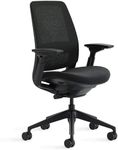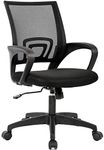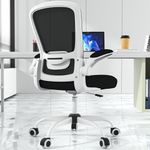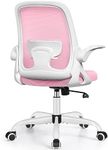Buying Guide for the Best Office Chair For Short Person
Choosing the right office chair is essential for comfort, productivity, and long-term health, especially if you are shorter in height. The right chair will support your posture, reduce fatigue, and help you work efficiently. When shopping for an office chair as a shorter person, it's important to focus on features that allow for proper alignment of your feet, knees, and back. Understanding the key specifications will help you find a chair that fits your body and your workspace.Seat Height RangeSeat height range refers to how high or low the chair can be adjusted from the floor. This is crucial because your feet should rest flat on the ground with your knees at a 90-degree angle for optimal comfort and circulation. For shorter individuals, look for chairs with a lower minimum seat height. Typically, a seat height starting around 15 to 17 inches from the floor is suitable for people under 5'5". If you are much shorter, you may need an even lower range. Always check the lowest setting and try to match it to your leg length to ensure your feet are not dangling.
Seat DepthSeat depth is the distance from the backrest to the front edge of the seat. This matters because a seat that is too deep can cause your legs to dangle or put pressure on the back of your knees, while a seat that is too shallow may not provide enough support. For shorter people, a seat depth of 16 to 18 inches is generally more comfortable. When sitting back, you should have about 2 to 4 inches between the back of your knees and the seat edge. Look for chairs with adjustable seat depth or those specifically designed with a shorter seat.
Lumbar SupportLumbar support is the part of the chair that supports the lower back. Proper lumbar support helps maintain the natural curve of your spine and prevents slouching. For shorter users, it's important that the lumbar support aligns with your lower back, not too high or too low. Adjustable lumbar support is ideal, as it allows you to move it up or down to fit your body. If the support is fixed, make sure it matches your back's curve when you sit all the way back in the chair.
Armrest AdjustabilityArmrest adjustability refers to how much you can move the armrests up, down, in, or out. This is important because armrests that are too high or too far apart can cause shoulder or neck strain, especially for shorter people. Look for chairs with armrests that can be lowered enough so your arms rest comfortably with your shoulders relaxed. Ideally, the armrests should also move inward to support your elbows close to your body. Adjustable armrests help you maintain a natural posture and reduce fatigue.
Backrest HeightBackrest height is the vertical length of the chair's back support. For shorter individuals, a very tall backrest may not provide proper support and could push your head forward. A mid-back or adjustable backrest is often a better fit, as it can be positioned to support your upper and lower back without being too high. Make sure the backrest supports your back comfortably without forcing your shoulders or neck into an awkward position.
Seat Cushion FirmnessSeat cushion firmness refers to how soft or hard the seat feels. This affects comfort, especially if you sit for long periods. A cushion that is too firm can cause discomfort, while one that is too soft may not provide enough support. For shorter people, a medium-firm cushion is usually best, as it offers support without being too hard. Try to test the chair if possible, and make sure the cushion doesn't compress too much under your weight, which could lower the seat height further.



















